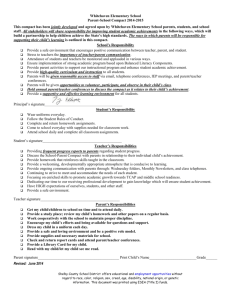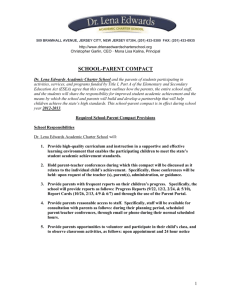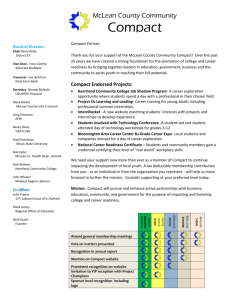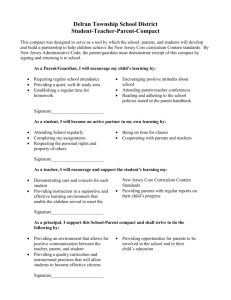Cambridge Community Compact for a Sustainable
advertisement
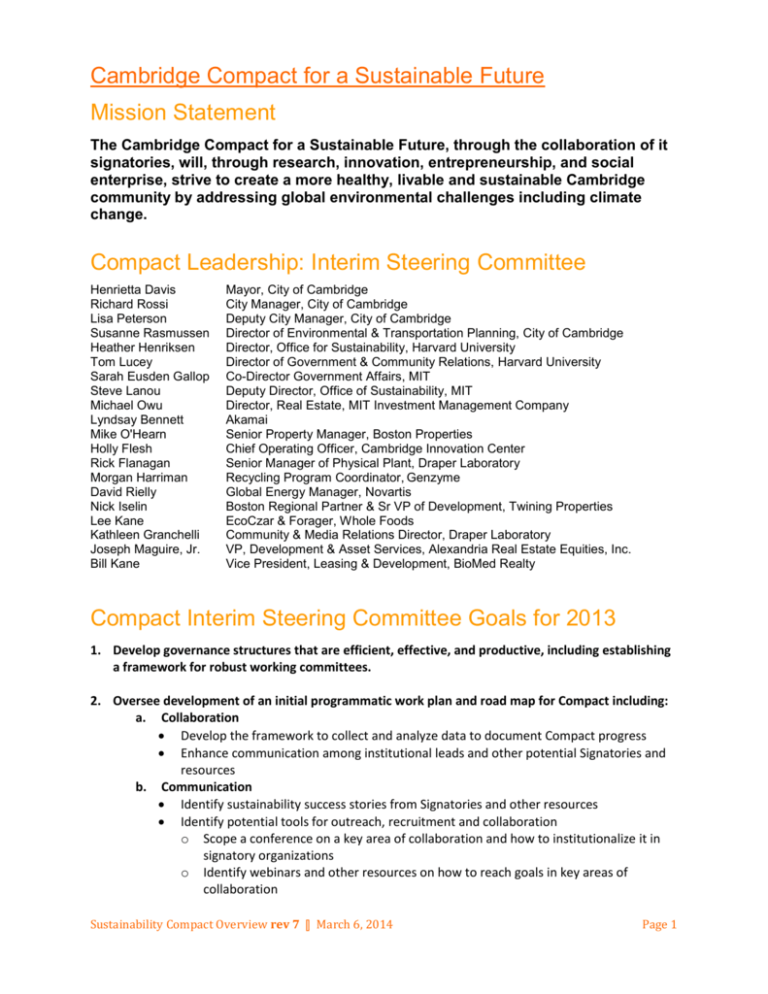
Cambridge Compact for a Sustainable Future Mission Statement The Cambridge Compact for a Sustainable Future, through the collaboration of it signatories, will, through research, innovation, entrepreneurship, and social enterprise, strive to create a more healthy, livable and sustainable Cambridge community by addressing global environmental challenges including climate change. Compact Leadership: Interim Steering Committee Henrietta Davis Richard Rossi Lisa Peterson Susanne Rasmussen Heather Henriksen Tom Lucey Sarah Eusden Gallop Steve Lanou Michael Owu Lyndsay Bennett Mike O'Hearn Holly Flesh Rick Flanagan Morgan Harriman David Rielly Nick Iselin Lee Kane Kathleen Granchelli Joseph Maguire, Jr. Bill Kane Mayor, City of Cambridge City Manager, City of Cambridge Deputy City Manager, City of Cambridge Director of Environmental & Transportation Planning, City of Cambridge Director, Office for Sustainability, Harvard University Director of Government & Community Relations, Harvard University Co-Director Government Affairs, MIT Deputy Director, Office of Sustainability, MIT Director, Real Estate, MIT Investment Management Company Akamai Senior Property Manager, Boston Properties Chief Operating Officer, Cambridge Innovation Center Senior Manager of Physical Plant, Draper Laboratory Recycling Program Coordinator, Genzyme Global Energy Manager, Novartis Boston Regional Partner & Sr VP of Development, Twining Properties EcoCzar & Forager, Whole Foods Community & Media Relations Director, Draper Laboratory VP, Development & Asset Services, Alexandria Real Estate Equities, Inc. Vice President, Leasing & Development, BioMed Realty Compact Interim Steering Committee Goals for 2013 1. Develop governance structures that are efficient, effective, and productive, including establishing a framework for robust working committees. 2. Oversee development of an initial programmatic work plan and road map for Compact including: a. Collaboration Develop the framework to collect and analyze data to document Compact progress Enhance communication among institutional leads and other potential Signatories and resources b. Communication Identify sustainability success stories from Signatories and other resources Identify potential tools for outreach, recruitment and collaboration o Scope a conference on a key area of collaboration and how to institutionalize it in signatory organizations o Identify webinars and other resources on how to reach goals in key areas of collaboration Sustainability Compact Overview rev 7 ⫿ March 6, 2014 Page 1 3. Select and appoint the Compact Board a. Select Initial Board – By consensus, the Interim Steering Committee shall determine the initial iteration of the Board. b. Identify Officers – The Board shall determine the first slate of Officers for the Compact. 4. Recruit Signatories, Resource Members a. Identify Potential Signatories - Encourage business and property owners taking action in key areas of collaboration to become signatory to the Compact. b. Identify Resources - Identify and recruit potential resource members for advisory and committee participation. 5. Consolidate Internal Committees Compact Governance Recommendations The governance model for the Compact should accomplish the following: Ensure the sustainability and health of the Compact; Create the structure to support growth in the form of new Signatories and collaborators; Advance the effective development and maintenance of areas of collaboration, initiatives, and future projects; Encourage the Compact and its Signatories to achieve both their collective and individual organizations’ goals. The Governance Structure The Compact’s governance structure is specifically focused on achieving broad collaboration in the sustainability domain, and ensuring the long-term health of the Compact and its initiatives. To this end, the governance approach supports broad engagement among Signatories and allows significant latitude to define areas of focus and engagement that strengthen both the Compact and its Signatories by allowing them to achieve their goals. The governance structure is also designed to allow for robust engagement of community expertise through advisory and sub-committee roles for individuals and nonsignatory organizations who can serve by invitation in a resource capacity. The Compact governance centers on a board (the “Board”), nominated annually by a nominating committee and ratified at an annual meeting of the Compact. In addition, the nominating committee will put forward a slate of officers, which shall also serve as the Compact’s Executive Committee, including a Chairperson, two Vice Chairs, a Secretary, and a Treasurer. The Board shall be composed of two categories of individuals - Officers and At-Large members - comprised as follows: Each year, one member of the Board shall be designated by each of the following founding signatories to serve a one-year term: The City of Cambridge Mayor, the City of Cambridge City Manager, The President of Harvard University, and the MIT President. Initially, twelve members shall be ”elected” from among the signatory organizations to serve one, two, or three-year terms, with four members rotating off the Board each year. Subsequently, each new class of four Board Members shall be elected to a three year term. Sustainability Compact Overview rev 7 ⫿ March 6, 2014 Page 2 Officers shall be elected to a presumptive two-year term, with the slate of Officers to be nominated and ratified annually. To the extent possible, the Officers’ terms shall be staggered in order to maintain continuity. Members of the Board shall be elected/ratified annually by eligible voters as defined by agreed upon practices. The Responsibilities of the Board It is the responsibility of the Board to ensure the current and future health of the Compact. The Board will be responsible for initiating, and keeping current, a strategic plan for the Compact. This will require the Board to annually assess the current state of the Compact and identify areas of focus. Regardless of the changing needs of the Compact, the board shall have the following responsibilities: Initiate, and keep current, a strategic plan for the Compact. Select a nominating committee charged with formulating a slate of Board Members and Officers annually Effectively manage financial contributions made in support of the Compact Facilitate, from time to time, a strategic planning and governance review. Actively engage in drawing new organizations into the Compact. Identify and execute processes to secure needed resources including funding, staff, etc. Act on behalf of the Compact in creating partnerships that serve its goals. Actively participate in communications and outreach activities. Create and abide by a Board Calendar with annual administrative, meeting, funding, and communications milestones. The primary focus areas of the Board may shift over time with the evolving needs of the Compact. As such, Board members must have a strong commitment to the success of the Compact and both the willingness and the ability to adapt to its changing needs. The Board shall meet bi-monthly in accordance with the Board Calendar, and shall hold an Annual Meeting in April of each year. Committees The work of the Compact will be conducted through committees, of which there shall be two classifications: Standing Committees and Ad Hoc Committees. There shall be six Standing Committees including an Executive Committee (as herein defined), a Nominating Committee, a Finance Committee, a Membership Committee, a Communication Committee, and a Programming and Policy Committee. Each Standing Committee shall be chaired by a member of the Board of Directors. Each Standing Committee chair shall prepare a slate of members for ratification by the Board each year. Ad Hoc Committees may be constituted from time to time at the election of the Board. Ad Hoc Committees shall focus on the Areas of Collaboration identified in the Compact and may be chaired by a member of the Board of Directors or a designee from among the Signatory organizations. Each Ad Hoc Committee chair shall prepare a slate of members for ratification by the Board each year. Each Committee, through its chair or a designee, shall give a report at each meeting of the Board of Directors, or from time to time as required. It is anticipated that Committees will meet on a bi-monthly basis, in those months in which the Board does not meet. Sustainability Compact Overview rev 7 ⫿ March 6, 2014 Page 3 Compact Membership The Compact membership shall be comprised of a group of Signatories, meeting certain defined eligibility criteria that the Board will determine from time-to-time, who will work together to build a coalition to engage in sustainability programs and initiatives, including growing the number of signatories. All Signatories are encouraged to explore ways to better connect researchers, students, entrepreneurs, and social enterprises in the sustainability field that are seeking collaborators. The Compact will be supported by a pool of Resource Members that allow for robust engagement of community expertise, through advisory and sub-committee roles, for individuals and non-signatory organizations who may serve by invitation as a resource for specific projects. There shall be a meeting of the full Compact membership twice annually, with the Compact Annual Meeting serving as one such meeting. Eligibility for Signatory Membership Signatories to the Compact should meet the following eligibility criteria: Be a corporate, public agency, non-profit, or institutional entity Have a physical presence in Cambridge Have operational control of significant environmental impacts Have established demonstrative leadership in sustainable practices and innovation Eligibility for Resource Membership Resource Members should meet the following eligibility criteria: An individual (may have organizational resources) Expertise in an Area of Collaboration Must be affiliated with, and participate in, a committee or working group Must have established demonstrative leadership in sustainable practices and innovation Sustainability Compact Overview rev 7 ⫿ March 6, 2014 Page 4

